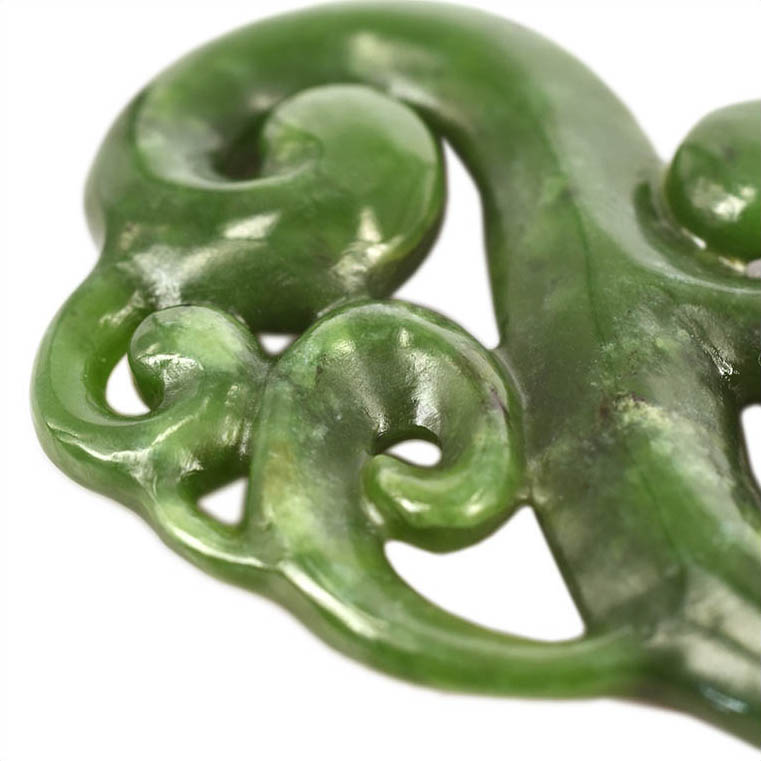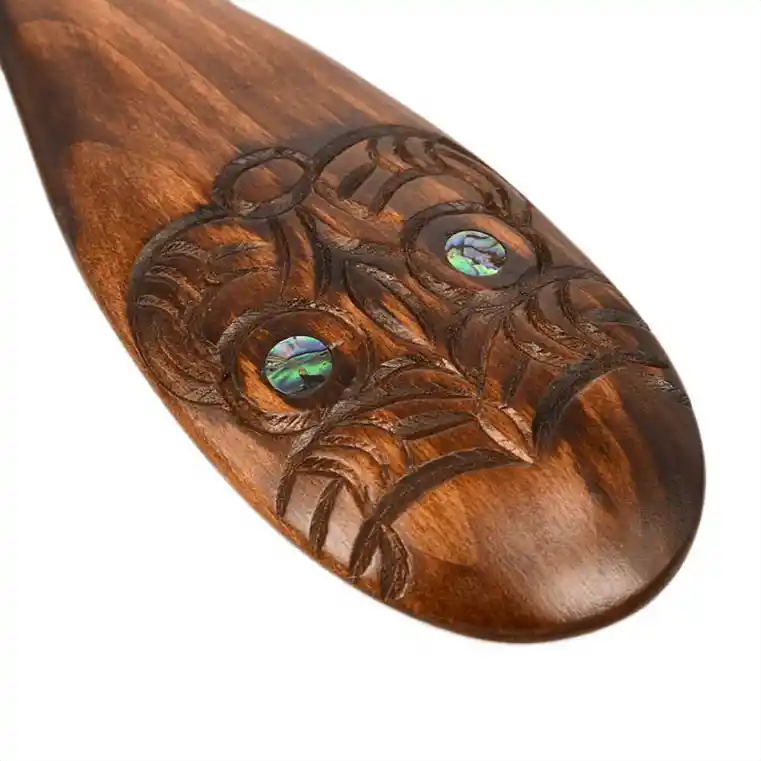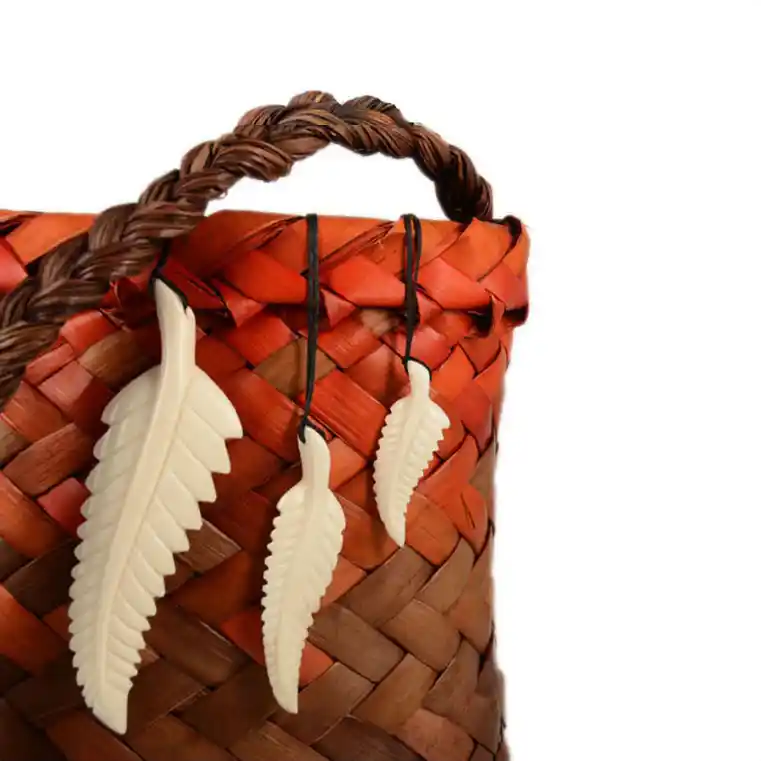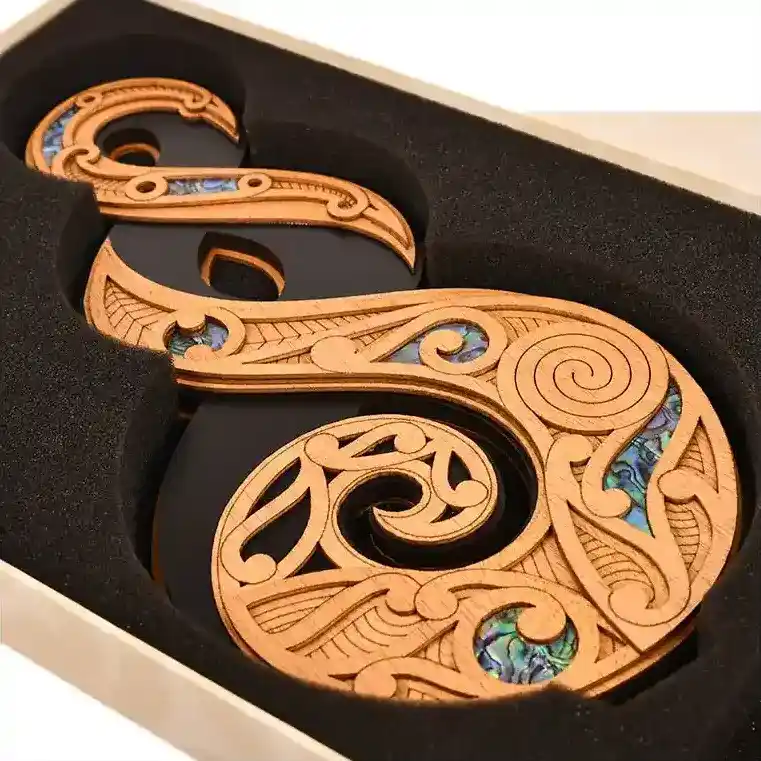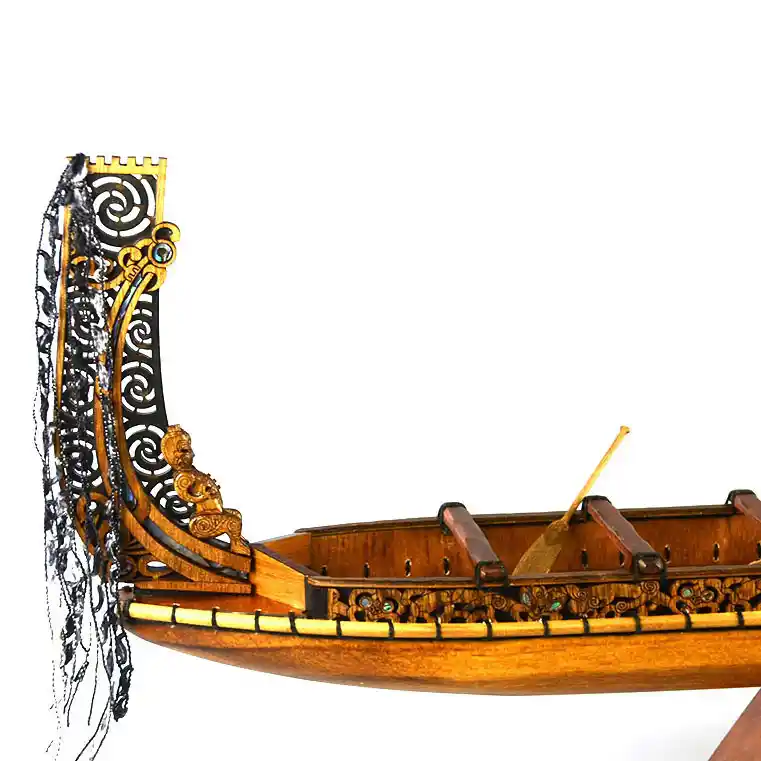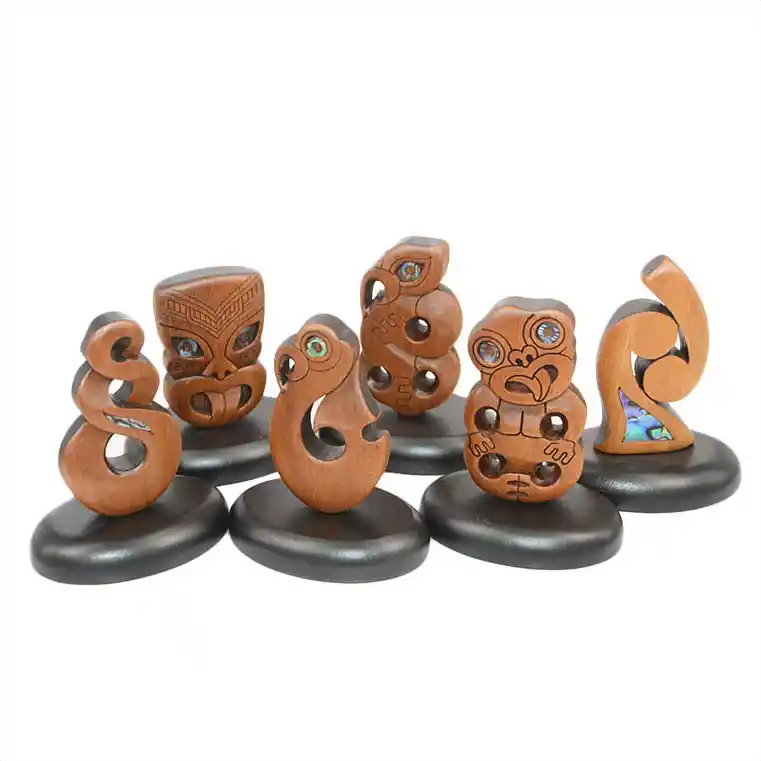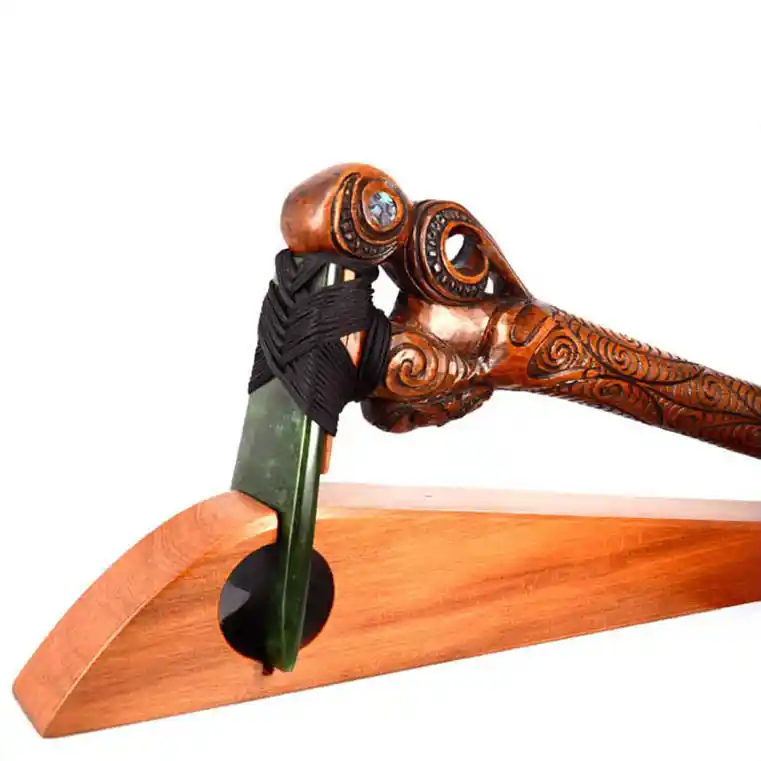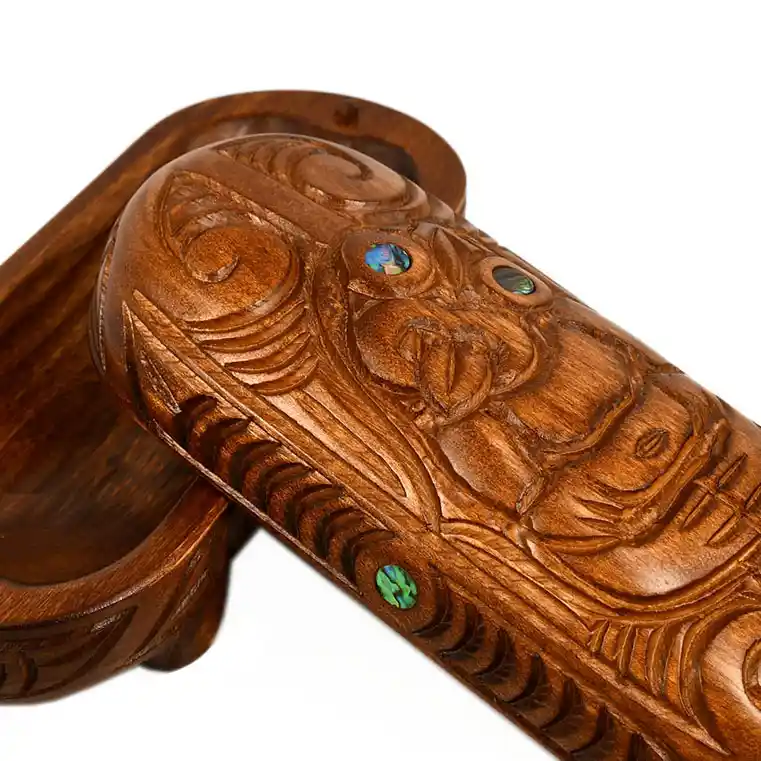The Art and Evolution of Māori Carving: From Traditional Taonga to Contemporary Expressions
Māori carving (whakairo) represents one of the most distinctive and culturally significant art forms of Aotearoa New Zealand, embodying
centuries of tradition, spirituality, and cultural knowledge. The intricate carvings found in wood, bone, and pounamu (greenstone) tell the
stories of ancestors, preserve tribal histories, and maintain connections to the spiritual world. Today, these traditional art forms
continue to evolve through innovative techniques like laser cutting, allowing the rich cultural heritage to find new expressions while
maintaining its profound significance.
The Sacred Origins of Whakairo
According to Māori oral tradition, the art of wood carving was brought to their ancestors by the cultural hero Ruatepupuke. In this legendary account, Ruatepupuke's son Manuruhi offended Tangaroa, the god of the sea, who transformed the son into a wood carving adorning his underwater house. Upon discovering this, Ruatepupuke journeyed beneath the sea, where he heard the carved ancestor posts of Tangaroa's house speaking to one another. After rescuing his son and several carved posts, Ruatepupuke returned to the human world, introducing the art of carving to humanity.
This origin story establishes carving as a taonga tuku iho—a divine gift from the gods handed down from ancestors—requiring ritual respect and reverenc. The reference to "talking carvings" in the legend reflects the aesthetic standard that Māori carvers aspire to, where a masterful carving is said to "speak" to the viewer.
With no written language of their own, pre-European Māori passed on knowledge orally through stories, waiata (songs), and whakapapa (genealogy). Art, particularly carving, became a crucial medium for transferring and preserving knowledge, using natural resources such as harakeke (New Zealand flax), wood, bone, shell, and pounamu. These carved artifacts, handed down through generations of tribal elders, became taonga—sacred objects or treasures embedded with mana (spiritual power and prestige).
The Evolution of a Distinctive Art Form
The art of wood carving was brought to New Zealand by the ancestors of the present-day Māori, who likely settled the islands around 1100 A.D. The earliest examples of Māori carving show clear stylistic connections to Eastern Polynesia, where the ancestors of the Māori originated. One early example is Uenuku, a stylized representation of the rainbow god, which has been compared to Hawaiian carvings.
As generations passed, a distinctively Māori carving style gradually emerged, developing into what is recognized as the classic Māori style around 1500. Unlike its more sparely ornamented predecessors, classic Māori wood carving is characterized by boldly rendered three-dimensional forms whose surfaces are engraved with intricate designs. These designs often incorporated curved patterns and spirals inspired by New Zealand's native plants, particularly the unfurling fern frond known as the koru.
Regional variations in carving styles emerged, with the main distinctions being the "serpentine" and the "Eastern square style". European colonization had a profound impact on Māori culture and art forms, with large carved meeting houses (whare whakairo) becoming more common as expressions of tribal mana and worldview.
Traditional Materials and Forms
Wood Carving (Whakairo Rakau)
Wood carving has played a central and respected role in Māori culture since before the first arrival in New Zealand. Whakairo rakau (wood carving) primarily uses native timbers, particularly the majestic kauri and totara trees, which represent Tāne Mahuta, the god of the forest. Each carving tells a story and records a piece of history, with different tribal styles expressing unique identities and histories.
Intricate wood carvings can be found on meeting houses (whare whakairo) and marae throughout New Zealand, created by master carvers (tohunga whakairo). These carvings tell each tribe's story and depict important historical ancestors and events. Wood carving is also used to create waka (canoes), weapons, and musical instruments.
The carved figures in meeting houses are not religious idols but represent renowned tipuna (ancestors) of the tribe. The wheku (carved face) found at the apex of the gable on a carved house symbolizes an important ancestor after whom the house was named. The house itself represents the ancestor's body—the sloping bargeboards being arms, the rafters representing ribs, and the inside representing the stomach or bosom.
Bone Carving
Bone carving represents another significant dimension of Māori carving traditions. Traditionally created from whale bone but now often using beef bone, these carvings are primarily fashioned into jewelry and ornamental items. Māori bone carvers initially produced practical tools like fishhooks and heru combs, but the artform evolved to capture the myths and legends of the Māori people through decorative and wearable pieces.
These bone carvings carry rich symbolism tied to the natural environment. For example, the fishhook (Hei Matau) pendant represents prosperity, abundance, fertility, and strength, while also serving as a good luck charm, especially for those traveling over water. Bone carvings are believed to have a special quality that allows them to blend with the wearer's body over time, taking on their spirit and energy.
Pounamu (Greenstone) Carving
Pounamu, a form of jade mainly found in the Arahura Valley on New Zealand's West Coast, holds profound sacred significance in Māori culture and represents power and status. Sir Tipene O'Regan eloquently expressed its importance:
"It has been sought after and fought for, wept over and treasured, for the whole human story of Aotearoa. Its merits as weapon or ornament, tool or treasure, are the stuff of the proverbial Whakataukī and metaphor; possession of pounamu has long been a mark of wealth and prestige, a mark of mana".
Throughout history, Māori have transformed pounamu into various objects including tools, weapons, jewelry, and talismans, often incorporating significant Māori symbols. In Māori tradition, greenstone is typically gifted rather than purchased or carved for oneself, as it is considered a gift from the land. However, it is fine to purchase a pounamu carving for yourself.
The Ngāi Tahu iwi tribe, designated as the lawful protectors of greenstone in 1997, are the only ones permitted to mine it for commercial or tribal purposes. They bear the responsibility of sustainable management, caring for the rivers from which pounamu originates and supporting the communities and artists who work with this precious stone.
Symbolism and Cultural Significance
Māori carvings in wood, bone, or stone feature unique designs with special meanings that are rich in symbolism, though styles differ between tribes. Common symbols include the tiki, which represents the human figure, and the manaia, a creature with a bird-like head and serpent-like body associated with guardianship.
Traditional patterns used in carving were inspired by the natural environment, including spider webs (pūngāwerewere), fish scales (unaunahi), and the unfurling fronds of the fern (koru). These motifs connect the artwork to the natural world and ancestral knowledge.
Another important decorative art form is kōwhaiwhai, traditional Māori painted scroll patterns primarily used for decorative purposes. These designs commonly adorn the ridgepole and rafters of wharenui (meeting houses), where they depict tribal lineage, capture memories, and tell stories.
Modern Innovations: Laser Cut Māori Art
The traditional art of Māori carving continues to evolve through modern technologies, particularly laser cutting, which allows for precise replication of intricate traditional designs while expanding creative possibilities. Contemporary artists are merging customary Māori art forms with modern technology to create innovative expressions that honor tradition while embracing the present.
Aotearoa.co.nz features contemporary Māori art including framed Māori manaia, tiki, wheku, fishhooks and pikorua crafted from plantation-grown gaboon using laser technology. These pieces boast super fine detail, paua shell inlay, and are mounted on earth-toned backgrounds inside custom glass-covered shadow box frames. Each piece is individually signed by the artist and includes descriptions of its cultural significance. Beautiful Māori gifts created by Mike Carlton and his team.
Our site also features laser cut Māori signs and the colourful kōwhaiwhai and frangipani pendants and large heart and frangipani wall decorations by Sonz.
Preserving Tradition Through Innovation
The renaissance of traditional Māori carving that began in the 20th century continues today, with both traditional methods and modern innovations contributing to the preservation and evolution of this sacred art form. Educational institutions like Te Wānanga o Aotearoa, Te Wānanga o Raukawa, and Te Puia (the New Zealand Māori Arts and Crafts Institute) teach carving, ensuring the transmission of knowledge to new generations.
Traditional carving continues to thrive and has major spiritual and cultural significance, particularly in the creation of whare whakairo (communal meeting houses). At the same time, the availability of laser-cut files featuring Māori designs allows for wider appreciation and application of these cultural motifs, with digital downloads available for personal use.
The balance between honoring traditional practices and embracing new technologies reflects the living nature of Māori culture—rooted in ancestral knowledge while continuing to grow and adapt. Through both time-honored techniques and modern innovations like laser cutting, the art of Māori carving continues its journey as a profound expression of cultural identity, spiritual connection, and artistic excellence.
Conclusion
From its legendary origins with Ruatepupuke to contemporary expressions, Māori carving represents a continuous thread of cultural knowledge, artistic innovation, and spiritual significance in Aotearoa New Zealand. The distinctive carvings in wood, bone, and pounamu serve as tangible connections to ancestors and embodiments of cultural narratives, while modern laser-cut designs demonstrate the adaptability and ongoing relevance of these traditional art forms.
Whether admiring a centuries-old carved meeting house, wearing a bone pendant whose design carries ancestral meaning, or appreciating contemporary laser-cut artwork that bridges traditional and modern worlds, we can recognise how Māori carving continues to "speak" across generations. In its evolution from traditional taonga to contemporary expressions, Māori carving exemplifies how cultural traditions can be both preserved and renewed through respectful innovation and artistic vision.
Beautiful Māori Carvings
Beautiful Māori carvings available at our online Aotearoa.co.nz shop in Devonport, Auckland, NZ.
Have a look photos of some of the carvings and artworks we feature on our site. We love the variety of carvings on our site and have sent them all over the world. And of course within New Zealand. Aotearoa.co.nz offers authentic greenstone carvings, bone carvings and wood carvings. We work with very talented artists from all over New Zealand.
Greenstone carvings from Aotearoa, New Zealand. Whether you are looking for greenstone (pounamu) carvings, bone carvings or authentic Māori wood carvings, you can find these NZ made items and artworks on our online shopping site.

